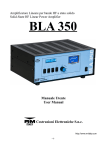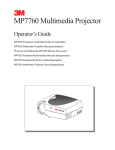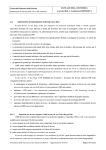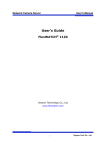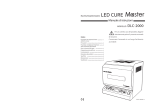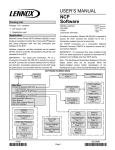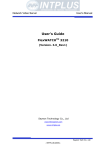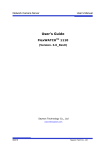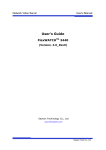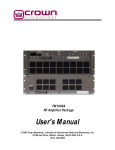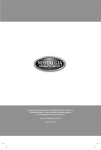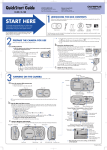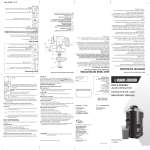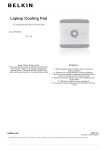Download Manuale Utente Users Manual 3Costruzioni Elettroniche S.n.c.
Transcript
Amplificatore Lineare per bande HF/50MHz a stato solido Solid-State HF/50MHz Band 1kW Linear Power Amplifier BLA 1000 Manuale Utente Users Manual 3 Costruzioni Elettroniche S.n.c. -1- 1. Introduzione L'amplificatore lineare BLA 1000 è un amplificatore lineare ad alte prestazioni costruito per l'uso con tutti i ricetrasmettitori HF in tutti i modi di trasmissione. Questo amplificatore usa due MosFets MRF157 configurati in classe AB2. Opera in tutte le bande da 160 (1,8 MHz) a 6 (52 MHz) metri in maniera lineare e senza interruzioni da 1,5 e 30MHz e da 48 a 55 MHz. Una ventilazione forzata interna a velocità variabile provvede al raffreddamento di tutte le parti dell'amplificatore, un circuito elettronico pilotato dal microprocessore ne controlla il funzionamento. Due ampi strumenti interni analogici ed un display LCD, vi tengono sempre informati sui parametri vitali dell'amplificatore, Potenza d'uscita, Potenza riflessa, Corrente di drain, Tensione di drain, Livello ALC e molti altri parametri sono visualizzabili per avere sotto controllo ogni momento lo stato di funzionamento dell'amplificatore. Vi raccomandiamo la lettura del presente manuale in tutte le sue parti prima della messa in funzione dell'amplificatore. Conoscere il funzionamento di tutte le sezioni dell'amplificatore vi permetterà un uso più performante ed eviterà errori che oltre a causare una perdita di potenza d'uscita potrebbe causare danni ai componenti anche in maniera irreversibile. Un uso attento e corretto vi farà apprezzare le "performance" del BLA 1000 per molti anni senza nessun intervento tecnico. Introduction The BLA 1000 Linear Amplifier is a high performance amplifier designed for use with all HF transceivers and all modes of transmission. The amplifier uses 2 MRF157 MosFets configured for Class AB2 operation. Operation is possible for all bands from 160 (1.8MHz) to 6 (52MHz) meters and without interruption from 1.5 to 30 MHz and from 48 to 55 MHz. It features microprocessor controlled variable speed forced air ventilation that provides cooling for all areas of the amplifier. Two large analogue meters and an LCD display show all of the amplifiers operational parameters; Output power, Reflected power, Drain current, Drain voltage, ALC level, and other parameters, enabling the operator to see the state of the amplifier at any time. This allows the user to obtain the maximum performance and avoid any possible operating errors resulting in a loss of output power and possible irreversible component damage. Attention to correct operating procedure and operating the amplifier within it’s capabilities will result in optimim performance and many years of trouble free use. -2- 2. Indice – Index 1 2 3 4 5 Introduzione – Introduction .............................................................................................................................. Indice – Index ................................................................................................................................................... Specifiche, precauzioni - Specifications, Cautions .......................................................................................... Descrizione parte Anteriore - Front description ............................................................................................... Descrizione parte Posteriore - Rear description .............................................................................................. 6 Italiano ..............................................................................................................................................................8 6.1 Rimozione dall'imballo ed ispezione ...........................................................................................................8 6.2 Procedura d'installazione ............................................................................................................................8 6.3 Connessione alla rete .................................................................................................................................8 6.4 Antenna .......................................................................................................................................................8 6.5 Massa ..........................................................................................................................................................8 6.6 PERICOLI ...................................................................................................................................................8 7 Funzionamento ................................................................................................................................................8 7.1 Impostazioni iniziali .....................................................................................................................................8 7.2 Orologio .......................................................................................................................................................9 7.3 Standby .....................................................................................................................................9 7.3.1 Menù .....................................................................................................................................9 7.3.1.1 ALC Set .......................................................................................................................9 7.3.1.1.1 Max Power ..................................................................................................9 7.3.1.1.2 No Power .....................................................................................................9 7.3.1.2 System ........................................................................................................................9 7.3.1.2.1 Time .............................................................................................................9 7.3.1.2.2 Date .............................................................................................................9 7.3.1.2.3 Day ..............................................................................................................9 7.3.1.2.4 Temp ............................................................................................................9 7.3.1.2.5 Restore default settings ..............................................................................9 7.3.1.3 Antenna .......................................................................................................................9 7.3.1.3.1 Banda ..........................................................................................................9 7.3.1.4 Int. VOX .......................................................................................................................9 7.3.1.4.1 Disabled ......................................................................................................9 7.3.1.4.2 Enabled .......................................................................................................9 7.3.1.4.3 RX Delay .....................................................................................................9 7.3.1.5 P. Supply .....................................................................................................................9 7.3.1.5.1 OFF Delay....................................................................................................9 7.3.1.6 Vent. ............................................................................................................................9 7.3.1.6.1 Vent. Speed .................................................................................................9 7.3.1.7 INFO ............................................................................................................................9 7.4 Operate .....................................................................................................................................9 7.4.1 Default Setting ...........................................................................................................................10 7.4.2 Visualizzazione stato amplificatore ...........................................................................................10 7.4.2.1 Display LCD ..............................................................................................................10 7.4.2.2 Strumenti Analogici ...................................................................................................10 7.4.2.2.1 MULTIMETER ...........................................................................................10 7.4.2.2.2 OUTPUT POWER .....................................................................................10 7.4.2.3 Indicazioni Lumisose .................................................................................................10 7.4.2.3.1 ON AIR ......................................................................................................10 7.4.2.3.2 WARNING .................................................................................................10 7.4.2.3.3 BAND ........................................................................................................10 7.4.2.3.4 ANTENNA ..................................................................................................10 7.4.3 Comandi ...................................................................................................................................10 7.4.3.1 Keyboard ...................................................................................................................10 7.4.3.2 METER ......................................................................................................................10 7.4.3.3 BAND.........................................................................................................................10 7.4.3.4 AUTO/Manual ............................................................................................................10 7.4.3.5 TX/ON .......................................................................................................................10 7.4.3.6 ANT A/B .....................................................................................................................10 Protezioni ...................................................................................................................................10 8.1 OVER Input Power ...................................................................................................................................10 8.2 OVER Temp ...................................................................................................................................11 8.3 OVER SWR ...................................................................................................................................11 8.4 FILTER FAULT ...................................................................................................................................11 8.5 Vdd Error ...................................................................................................................................11 8.6 OVER Id ...................................................................................................................................11 8.7 LOW Efficiency ...................................................................................................................................11 8.8 Power Supply FAUL...................................................................................................................................11 8 16 2 3 5 6 7 English Precautions ...................................................................................................................................12 16.1 Removal from packaging and inspection ................................................................................................12 16.2 Installation ...................................................................................................................................12 16.3 Connection to AC supply.........................................................................................................................12 16.4 Antenna ...................................................................................................................................12 -3- 17 18 16.5 GROUND ...................................................................................................................................12 16.6 WARNING ...................................................................................................................................12 OPERATION ...................................................................................................................................12 17.1 Initial Settings ...................................................................................................................................12 17.2 Time ...................................................................................................................................13 17.3 Standby ...................................................................................................................................13 17.3.1 MENU ...................................................................................................................................13 17.3.1.1 ALC Setting..............................................................................................................13 17.3.1.1.1 Max Power ..............................................................................................13 17.3.1.1.2 No Power .................................................................................................13 17.3.1.2 System.....................................................................................................................13 17.3.1.2.2 Date .........................................................................................................13 17.3.1.2.3 Day ..........................................................................................................13 17.3.1.2.4 Temp ........................................................................................................13 17.3.1.2.5 Restore default settings ..........................................................................13 17.3.1.3 Antenna .................................................................................................................. 13 17.3.1.3.1 Band ........................................................................................................13 17.3.1.4 Int. VOX .................................................................................................................. 13 17.3.1.4.1 Disabled ..................................................................................................13 17.3.1.4.2 Enabled ...................................................................................................13 17.3.1.4.3 RX Delay .................................................................................................13 17.3.1.5 PSU .........................................................................................................................13 17.3.1.5.1 OFF Delay................................................................................................13 17.3.1.6 Vent. ........................................................................................................................13 17.3.1.6.1 Vent. Speed .............................................................................................13 17.3.1.7 INFO ........................................................................................................................13 17.4 Operate ...................................................................................................................................13 17.4.1 Default Setting .........................................................................................................................14 17.4.2 Monitoring the state of Amplifier..............................................................................................14 17.4.2.1 Display LCD ............................................................................................................14 17.4.2.2 Analogue panel meters .......................................................................................... 14 17.4.2.2.1 MULTIMETER .........................................................................................14 17.4.2.2.2 OUTPUT POWER ...................................................................................14 17.4.2.3 On Air and Warning LED's ......................................................................................14 17.4.2.3.1 ON AIR ....................................................................................................14 17.4.2.3.2 WARNING ...............................................................................................14 17.4.2.3.3 BAND ......................................................................................................14 17.4.2.3.4 ANTENNA ................................................................................................14 17.4.3 Front Panel controls ................................................................................................................14 17.4.3.1 Keyboard .................................................................................................................14 17.4.3.2 METER ....................................................................................................................14 17.4.3.3 BAND.......................................................................................................................14 17.4.3.4 AUTO/Manual ..........................................................................................................14 17.4.3.5 TX/ON .....................................................................................................................14 17.4.3.6 ANT A/B ...................................................................................................................14 Protections ...................................................................................................................................14 18.1 OVER Input Power ..................................................................................................................................14 18.2 OVER Temp ...................................................................................................................................14 18.3 OVER SWR ...................................................................................................................................15 18.4 FILTER FAULT ...................................................................................................................................15 18.5 Vdd Error ...................................................................................................................................15 18.6 OVER Id ...................................................................................................................................15 18.7 LOW Efficiency ...................................................................................................................................15 18.8 Power Supply FAUL.................................................................................................................................15 -4- 3. SPECIFICHE – SPECIFICATIONS Frequenza - Frequency : 1.5 ~ 30 MHz 48 ~ 55 Mhz all amateur bands including WARC bands Modi - Mode : AM, FM, SSB, CW, RTTY Potenza di pilotaggio - RF Drive : 100W typ. (110W max.) Potenza d'uscita - Output Power : 1.0 kW CW (typ.) (900 W on 1,8 MHz band) Tensione di drain - Drain Voltage : 48 V Corrente di drain - Drain Current : 45 A max. Impedenza d'ingresso - Input Impedance : 50Ω (unbalanced) Impedenza d'uscita - Output Impedance : 50Ω (unbalanced) Transistor di potenza - Final Transistor : MRF157 x 2 (MOS FET by M/A COM) Configurazione - Circuit : Class AB push-pull Metodo di raffreddamento - Cooling Method : Forced Air Cooling Microprocessore - MPU : PIC 18F4620 Strumenti - Meters : Potenza d'uscita - Output Power 2.5 kW Potenza riflessa - Reflected Power Pr 400W Corrente di drain - Drain Voltage Vd 60V Corrente di drain - Drain Current Id 60A Protezioni – Protections: Potenze d'ingresso – Input Power Tensione di drain – Drain Voltage Corrente di drain – Drain Curren Errore Filtri – Wrong Filter R.O.S. - S.W.R. Temperatura – Temperature Rendimento - Efficiency Connettori Ingresso/Uscita - Input/Output Connectors : UHF SO-239 with low loss Teflon insulator Alimentazione - AC Power : AC 180 ~ 264 Vac 15,5A max. Consumo - AC Consumption : 2,2 kVA max. when TX Dimensioni - Dimension : 495 x 230 x 462 mm (W x H x D) Peso - Weight : Approx. 30 kg. Or 66,1 lbs. Accessori - Accessories : AC Power Cord x 1 -5- 4. Descrizione parte anteriore – Front Description 1. Tastiera 1. Keyboard 2. Display LCD 2. LCD Display 3. Multimetro 3. Multimeter 4. Wattmetro 4. Wattmeter 5. ON AIR 5. ON AIR 6. WARNING 6. WARNING 7. BAND 7. BAND 8. ANTENNA 8. ANTENNA 9. POWER/ON 9. POWER/ON per la navigazione e inserimento dati nei menù For navigation and data input in the menus Visualizza l'orario e molti parametri di funzionamento visualizza il parametro impostato da e Displays the time and operational parameters Displays the chosen parametere Visualizza la potenza d'uscita Displays output power Si illumina quando l'amplificatore è in trasmissione Illuminates during transmission Indica una condizione di allarme, eccessiva potenza d'ingresso, eccessiva temperatura, allarme generico Indica il filtro di banda inserito Indica l'antenna inserita Interruttore di accensione dell'amplificatore Indicates excessive input power, high temperature and general alarm fault conditions Indicates the currently selected band filter Indicates the selected antenna Amplifier ON/OFF switch 10. Standby/ON 10. Standby/ON 11. METER 11. METER 12. BAND 12. BAND 13. Auto/Manual 13. Auto/Manual 14. TX/ON 14. TX/ON 15. ANT A/B 15. ANT A/B Interruttore di attivazione dell'amplificatore Standby / Operate switch Seleziona quale parametro visualizza ] Parameter selection] Selezione manuale del filtro di banda Manual selection of band filter Seleziona il modo di selezione dei filtri passa-basso Mode selection for band filter attiva manualmente la trasmissione Manual PTT switch Seleziona manualmente l'antenna attiva Antenna selection -6- 5. Descrizione parte Posteriore - Rear description 1. ANT-B 1. ANT-B 2. ANT-A 2. ANT-A 3. RTX 3. RTX 4. Interruttore di rete 4. Net switch 5. Fuse 5. Fuse 6. Spina ISO 6. Fuses box 2x16A (230V) 2x32A (110V) ISO Plug 7. RS232 7. RS232 Connetore SO239 Antenna B Antenna B SO329 connector Connetore SO239 Antenna A Antenna A SO329 connector Connetore SO239 Ricetrasmettitore Transceiver SO329 connector Interruttore generale Main switch Portafusibili 2x16A (230V) 2x32A (110V) Connettore del cavo di rete Connettore di comunicazione seriale 8. ALC gain AC Main Socket Serial communication connector 8. ALC gain Regolazione azione ALC 9. ALC level Regolazione soglia ALC 10. ALC ALC gain setting 9. ALC level ALC threshold setting 10. ALC Connettore ALC ALC connector 11. PTT 11. PTT 12. PTT set 12. PTT set 13. Adesivo 13. Sticker Connettore PTT PTT connector Seleziona il funzionamento della connessione PTT PTT mode setting Descrizione connessioni e dati di targa Connections and technical data -7- dell'intensità luminosa di lampadine poste nello stesso locale dell'amplificatore, i conduttori di rete probabilmente sono di sezione insufficiente per l'uso in sicurezza dello stesso. Italiano 6. Precauzioni 6.1 Rimozione dall'imballo e Ispezione Rimuovere, con molta attenzione, il BLA 1000 dal proprio imballo, controllare che il lineare non abbia nessun segno visibile di danni. Agire delicatamente ogni controllo e interruttore per controllare che abbiano un normale funzionamento. Se è rilevato qualche danno, fate una relazione dettagliata ed inviatela o consegnatela immediatamente al vostro fornitore. Conservare l'imballo completo da riutilizzarsi in caso di necessità. E' obbligatorio l'uso dell'imballo originale in caso di rientro presso un centro di riparazione. 6.2 Procedura d'installazione L'amplificatore deve essere posto in modo che vi sia un ampio spazio attorno, in modo che il flusso d'aria sia libero di circolare permettendo una corretta ventilazione di tutte le parti, non deve essere esposto direttamente alla luce solare ed il luogoo deve essere fresco ed asciutto. Non porre libri, carta, o altri oggetti sulla parte superiore del BLA 1000, non porre nulla che possa ostruire la griglia posteriore e laterale. Una limitazione del flusso di ventilazione può danneggiare in maniera irreversibile il lineare. Per il dettaglio delle connessioni di un'installazione tipica del BLA 1000, fare riferimento al capitolo 5. L'ingresso ALC del ricetrasmettitore va connesso all'uscita ALC (d) del BLA 1000 (fare riferimento al capitolo 7.3.1.1 per eseguire il corretto setting), l'uscita PTT del ricetrasmettitore all'ingresso PTT (e) del lineare. In caso di mancato uso di questa connessione è possibile usare il comando manuale sul frontale (h)o attivare da menù un circuito interno al BLA 1000 che fornisce il segnale necessario, per un miglior controllo della commutazione, si consiglia in ogni caso l'uso dell'ingresso PTT. Entrambi i connettori sopra menzionati sono di tipo RCA. Usare un corto spezzone di cavo coassiale tipo RG-58A/U o RG8A/U o equivalenti per l'interconnessione dell'uscita del ricetrasmettitore al connettore RTX (]) del BLA 1000. Per la connessione delle uscite ANT ([ e \) del BLA 1000 all'antenna non usare cavo tipo RG-58 ma solo un cavo che sopporti ampiamente la potenza d'uscita, cavi adeguati sono RG8A/U, RG-213/U o equivalenti, si consiglia di usare sempre entrambe le uscite ANT A e ANT B per evitare che accidentalmente l'amplificatore venga posto in trasmissione senza un carico, se non è presente una seconda antenna si può utilizzare un carico fittizio di potenza adeguata. Il ricetrasmettitore usato per pilotare il BLA 1000 deve essere in grado di fornire una potenza pari a 100 W per avere la massima potenza dichiarata in uscita al lineare. 6.3 Connessione alla Rete L'alimentatore per il funzionamento del BLA 1000 è incluso al suo interno, è in grado di operare alle tensioni di rete da 180 a 260 Vac 50/60 Hz. Prima di connettere la spina di rete assicurarsi della corretta tensione di lavoro scritta sull'adesivo posteriore (g). ATTENZIONE !!!! L'uso dell'amplificatore con una tensione di rete impropria provoca danni permanenti, la garanzia non copre i danni provocati da un'alimentazione impropria o con un fusibile non corretto. 6.4 ANTENNA Il BLA 1000 è costruito per l'uso con antenne che presentano un carico resistivo di 50Ω sulla frequenza di lavoro, in caso di uso di un'antenna che non risponde a questi requisiti si consiglia l'uso di un adattatore d'impedenza o di un accordatore, in grado di portare l'impedenza vista dall'amplificatore alla sua uscita nei limiti richiesti. Si ricorda che accessori a valle dell'amplificatore devono ampiamente sopportare la potenza d'uscita dello stesso, accessori inadeguati possono provocare danni irreversibili all'amplificatore. 6.5 MASSA Questo amplificatore deve essere connesso all'impianto di terra della stazione radio. Verificare che l'impianto di terra della stazione sia di ottima qualità, questo eliminerà molti disturbi in ricezione, preverrà accumulo di cariche statiche ed eviterà che ci siano punti a tensione RF elevata in trasmissione sulle parti metalliche che è possibile toccare. Per evitare disturbi RF può essere utile porre una ferrite di soppressione EMI (Clamp-on ferrite cores) su ogni cavo di connessione all'amplificatore. 6.6 PERICOLI All'interno dell'amplificatore sono presenti tensioni elevate e pericolose. Prima di rimuovere il coperchio dell'amplificatore assicurarsi di avere disconnesso il cavo di rete ed i cavi di connessione all'antenna ed al ricetrasmettitore. Se si sentono rumori od odori anomali, spegnere immediatamente l'amplificatore, fare un controllo su tutte le connessioni e rivolgersi ad un centro di assistenza autorizzato. Non sottoporre l'amplificatore ad urti, umidità, luoghi polverosi e caldi, operare una pulizia periodica dagli accumuli di polvere. Non immettere in ingresso una potenza maggiore di 110W, l'eccesso di potenza d'ingresso è potenzialmente distruttiva e fa' decadere la garanzia. L'amplificatore è provvisto da molte sofisticate protezioni ma l'uso reiterato in condizioni di pericolo può comunque determinare un danno permanente all'amplificatore. L'uso con un filtro di banda errato o senza un'antenna collegata può essere distruttivo se è operato alla massima potenza. Le regolazioni all'interno dell'amplificatore sono settate in fase di taratura in fabbrica con una adeguata strumentazione, la loro modifica fa' decadere la garanzia. 7. FUNZIONAMENTO Prima di iniziare qualsiasi operazione verificare che la tensione presente alla presa d’alimentazione di rete corrisponda alla tensione nominale scritta sull’adesivo posteriore (g). Verificare che un’antenna adeguata sia connessa al connettore ANT A del lineare (\). 7.1 Impostazioni iniziali Il BLA 1000 deve essere connesso ad una presa di rete indipendente senza interporre adattatori o altri accessori che potrebbero provocare surriscaldamenti delle connessioni danneggiandole. I conduttori del circuito di rete non devono essere inferiori a 2,5 mm² per tensioni di 200/220/240 Vac o #10 AVG per tensioni di 100/110/120 Vac. Se durante l'uso del BLA 1000 si nota un notevole abbassamento -8- Il ricetrasmettitore, usato per pilotare il BLA 1000, se necessario, deve essere accordato prima che possa operare in accoppiamento al lineare. Se è necessario l’accordo dell’RTX deve essere eseguito con l’interruttore d posto su Stadby (scritta standby sul display k) oppure deve essere posizionato su OFF l'interruttore POWER (c). Prima di usare l'amplificatore è necessario adattare il livello della tensione ALC al ricetrasmettitore (fare riferimento al capitolo 7.3.1.1 per eseguire il corretto setting). Posizionare i comandi del BLA 1000 nel seguente modo (fare riferimento al paragrafo 4): Power/ON ....................................OFF Standby/ON .................................OFF Meter ...........................................Vdd Band AUTO/MANUAL ...........................AUTO TX/ON...........................................OFF ANT A/B........................................A 7.2 Orologio Fornire alimentazione all'amplificatore posizionando su ON l'interruttore posteriore (^ Par. 5). Si illumina leggermente il Display LCD e vi viene scritto il modello dell'amplificatore, il giorno della settimana, la data e l'orario. La data e l'orario possono essere personalizzati accedendo al menù di impostazione (x par.x) 7.3 Standby Portare su On l'interruttore POWER (c par.4), si illumina completamente il display dell'LCD (\) , si illuminano entrambi gli strumenti analogici (]e^), si accendono le indicazioni relative alla banda (a) ed all'antenna (b). In questa fase l'amplificatore è in condizioni di attesa, non andrà in trasmissione se arriverà il comando ma sarà pronto non appena necessario. In questa fase il display indicherà: la prima riga indica il modello, la terza indica rispettivamente lo stato dell'amplificatore (Standby) l'antenna selezionata (AoB) e l'impostazione del comando filtri (AUT o MAN), è possibile agire sul comando ANT A/B per poter selezionare l'antenna connessa al ricetrasmettitore, anche il selettore filtri(f) se è attivo (commutatore g su Manual) imposta l'antenna in base alla banda selezionata e le impostazioni nel menù 7.3.1.2. 7.3.1 MENU' Quando l'amplificatore è in posizione Standby è accessibile il menù delle impostazioni. Premere il pulsante OK sulla tastiera ([), si entra in questo modo in un menù dove è possibile personalizzare molti dei parametri di funzionamento dell'amplificatore. Dopo essere entrati nel menù principale, è possibile scorrere tutte le voci premendo rispettivamente le frecce in alto o in basso, per entrare nel livello inferiore premere la freccia a destra, per uscire dal menù premere la freccia a sinistra o scorrere fino alla voce Esc e premere OK, per salvare le modifiche ad un parametro premere OK subito dopo averlo modificato. Un asterisco evidenzia l'impostazione attualmente attiva dove vi sono più voci selezionabili. 7.3.1.1 ALC Setting La prima voce del menù permette di avere le tensioni necessarie per la corretta regolazione del livello di ALC. Prima di iniziare il settaggio porre entrambe le regolazioni nel pannello posteriore (bec par. 5), con un piccolo cacciavite, tutte in senso orario. La cura della regolazione del livello ALC migliora le prestazioni dell'amplificatore e riduce la possibilità di danni in caso di operazioni errate. 7.3.1.1.1 Max Power selezionando questa opzione al connettore ALC (d cap.5) è presente il livello di tensione necessario a settare il livello di soglia dell' ALC. Con questa voce attiva regolare -9- ALC Level (c Cap.5) al punto che la potenza d'uscita del ricetrasmettitore inizia a scendere. 7.3.1.1.2 No Power Selezionando questa voce viene settato il massimo livello di ALC. Con questa voce attiva regolare ALC Gain (b Cap.5) fino a che la potenza d'uscita del ricetrasmettitore si riduca prossima allo 0 7.3.1.2 System Questa voce permette di accedere alle impostazioni dell'orologio e dell'unità di misura della temperatura visualizzata sul display. 7.3.1.2.1 Time impostare l'ora 7.3.1.2.2 Date impostare la data, in passi successivi viene proposto di impostare il giorno, il mese, l'anno ed il modo di visualizzare la data (giorno-mese-anno, mese-giorno-anno e anno-mese-giorno) 7.3.1.2.3 Day impostare il giorno della settimana 7.3.1.2.4 Temp è possibile selezionare se visualizzare la temperatura in gradi Celsius o Fahrenheit. 7.3.1.2.5 Restore default settings E' possibile ripristinare tutte le impostazioni di fabbrica utilizzando questo menù. ATTENZIONE !!!! verranno resettate tutte le impostazioni compresa l'assegnazione dell'antenna ad ogni singola banda. 7.3.1.3 Antenna All'interno della voce Antenna è possibile cambiare l'antenna assegnata di default ad ogni banda. 7.3.1.3.1 Banda per ogni banda è possibile vedere l'antenna attualmente assegnata e variarne il valore. 7.3.1.4 Int. VOX In questo menù è possibile attivare il circuito VOX interno all'amplificatore. E' comunque sempre preferibile l'uso del PTT per avere dei tempi di commutazione più ridotti. 7.3.1.4.1 Disabled Funzione VOX disabilitata 7.3.1.4.2 Enabled Funzione VOX abilitata 7.3.1.4.3 RX Delay Quando è abilitata la funzione VOX viene inserito un ritardo al ritorno in ricezione dell'amplificatore, di default è settato a 100ms, è possibile settare questo tempo in 6 passi fissi, 0 – 20 – 50 – 100 – 200 – 500 ms o utilizzando la voce manual setting tra 0 e 2,5 secondi in passi di 10 ms. 7.3.1.5 P. Supply qui è impostato il tempo dopo il quale l'alimentatore dello stadio di potenza si spegne se si è in ricezione. 7.3.1.5.1 OFF delay Il tempo di spegnimento dell'alimentatore è selezionabile tra 6 passi fissi, Always ON (sempre acceso) – 1 – 2 – 5 – 10 – 15 secondi e tra 1 e 137 secondi usando manual setting, di default l'impostazione è 2 secondi. 7.3.1.6 Vent. Le ventole che raffreddano l'amplificatore funzionano a velocità variabile in funzione della temperatura del dissipatore. Il dato impostato in questa voce determina la velocità e quindi la rumorosità delle ventole quando la temperatura dell'amplificatore è tra i 55 e 70 °C. 7.3.1.6.1 Vent. Speed E' possibile variare la velocità tra 7 passi, circa dal 20 al 80 % della velocità, di default è 4. 7.3.1.7 Info Questa voce fornisce informazioni relative alla versione e data del Firmware. 7.4 OPERATE Commutando l'interruttore Standby/ON su ON si entra in modalità Operate ed il BLA 1000 si prepara ad esprimere tutta la sua potenza. 7.4.1 Default setting Per avere un uso immediato dell'amplificatore è sufficiente posizionare il comando di selezione filtri di banda su AUTO, assicurarsi che l'antenna connessa sulla porta A (\ par.5) sia adeguata sia in frequenza che in potenza alla banda in cui si desidera operare. In questo modo tutte le operazioni del lineare sono completamente automatizzate e non vi è necessità di alcun intervento dell'operatore. Se non sono state cambiate le impostazioni di default, commutando in trasmissione il ricetrasmettitore, il lineare si pone in attesa del primo segnale RF in ingresso per determinare la frequenza ed impostare il corretto filtro di banda. Se alla successiva trasmissione è necessario cambiare il filtro di banda, il microprocessore provvederà autonomamente. 7.4.2 Visualizzazione stato Amplificatore Vengono visualizzati molti dati relativi al funzionamento dell'amplificatore alcuni dei quali personalizzabili secondo necessità o preferenze. 7.4.2.1 Display LCD Il display visualizzerà: Nella prima riga è visualizzata la scala riferita al Rapporto di Onde Stazionarie presente all'antenna, da 1:1 a 3:1. La seconda riga visualizza il livello di ROS in trasmissione. La terza riga visualizza rispettivamente la frequenza di trasmissione, l'antenna connessa e l'impostazione del controllo dei filtri passa-basso (AUT o MAN). La quarta riga Visualizza la temperatura del dissipatore ed il filtro inserito. 7.4.2.2 Strumenti analogici Sono presenti due strumenti analogici (] e ^ par. 4) sui quali vengono visualizzati alcuni parametri dell'amplificatore e la potenza d'uscita. 7.4.2.2.1 MULTIMETER (]) Tramite il commutatore METER (e) è possibile selezionare quale parametro viene visualizzato dal multimetro : Vdd è la tensione di alimentazione dello stadio di potenza, è presente solo in trasmissione e deve essere compresa tra 45 e 52 Vcc. Id è la corrente assorbita dallo stadio di potenza, deve essere inferiore a 45A. P. Ref. È la quantità di potenza riflessa dall'antenna, è proporzionale al livello del Rapporto di Onde Stazionarie ed alla potenza d'uscita, minore è e migliore è l'adattamento d'impedenza. ALC è il livello di tensione che è presente sul circuito di Controllo Automatico della potenza d'uscita. Dipende dalla temperatura, dal livello di ROS e dallo stato delle protezioni. 7.4.2.2.2 OUTPUT POWER (^) Questo strumento indica la potenza RMS d'uscita dell'amplificatore 7.4.2.3 Indicazioni luminose 7.4.2.3.1 ON AIR (_) l'accensione della scritta rossa TX indica che l'amplificatore è in condizioni di trasmissione. 7.4.2.3.2 WARNING (`) L'accensione di una di queste indicazioni rosse indica uno stato di pericolo per l'amplificatore. Pow indica il superamento della massima potenza d'ingresso all'amplificatore. -10- Temp indica il superamento della temperatura di normale funzionamento. A indica un errore generico, l'evento che lo ha generato viene scritto sul display LCD 7.4.2.3.3 BAND (a) Si illumina la banda relativa al filtro passa-basso impostato 7.4.2.3.4 ANTENNA (b) identifica l'antenna connessa all'amplificatore. 7.4.3 Comandi Sul pannello frontale sono presenti alcuni comandi che permettono di fare un uso più personalizzato dell'amplificatore. I comandi manuali son attivi solo quando l'amplificatore non è in trasmissione. 7.4.3.1 Keyboard ([) In operate sono attivi solo i due tasti relativi alle frecce destra e sinistra, utilizzando questi tasti è possibile cambiare il parametro visualizzato sul display LCD nelle prime due righe. I parametri visualizzabili sono: Output SWR 1:1 – 3:1 ROS in antenna Output power 0 – 1,5 KW Potenza d'uscita Input Power 0 – 150 W Potenza in ingresso PA Power 0 – 3 KW Potenza assorbita 7.4.3.2 METER (e) Questo commutatore seleziona quale parametro verrà visualizzato nello strumento MULTIMETER ( 7.4.2.2.1) 7.4.3.3 BAND (f) Con questo commutatore è possibile selezionare il filtro passa-basso corretto per la banda in uso. Funziona solo in modalità Manual di (g). 7.4.3.4 AUTO/MANUAL (g) con questo commutatore è possibile impostare la selezione dei filtri di banda, se in AUTO l'impostazione è automatica se in Manual è impostata tramite il commutatore BAND (e). 7.4.3.5 TX/ON (h) Con questo pulsante è possibile portare in trasmissione l'amplificatore, è utile se si sta utilizzando un ricetrasmettitore senza l'uscita PTT. 7.4.3.6 ANT A/B (i) Tramite questo pulsante si può cambiare l'antenna connessa con l'amplificatore in trasmissione e con il ricetrasmettitore in ricezione. La variazione permane fino alla variazione della banda in uso, quando cambia la banda in uso l'antenna assegnata è quella assegnata alla banda (7.3.1.2) 8. Protezioni L'amplificatore BLA1000 possiede vari sofisticati circuiti di protezione che intervengono in caso di necessità per proteggere i componenti dell'amplificatore. Tutte le misure sono gestite da un potente microprocessore che provvede ad identificare ogni possibile situazione di pericolo ed avvisa l'operatore con un segnale acustico e luminoso scrivendo sul display LCD il motivo dell'allarme. Se la situazione di pericolo lo richiede, l'amplificatore viene bloccato spegnendo l'alimentatore dello stadio di potenza e portando il sistema in standby, in questo caso è necessario eliminare la causa dell'intervento della protezione e spegnere e riaccendere l'amplificatore tramite l'interruttore di rete (^ par.5) o l'interruttore POWER/ON (c par.4). Nonostante le sofisticate protezioni l'uso reiterato in condizioni di pericolo può comunque determinare un danno permanente all'amplificatore. L'uso con un filtro di banda errato o senza un'antenna collegata può essere distruttivo se è operato alla massima potenza. 8.1 OVER Input Power Se la potenza di ingresso all'amplificatore supera i 110W vengono attivati un segnale audio e lampeggia l'indicazione rossa Pow dell'indicatore WARNING (` par.4). Se la potenza d'ingresso supera i 115W il lineare viene bloccato, l'operatore sentirà l'allarme audio, verrà accesa fissa la scritta Pow e sarà necessario spegnere e riaccendere l'amplificatore per resettare la protezione. In questi casi il Display indicherà nella prima riga: OVER INPUT POWER processore segnala un “FILTER FAULT”, se il funzionmento rimane dentro i limiti di sicurezza viene emesso un segnale audio e lampeggia il simbolo rosso A dell'indicatore WARNING (` par.4), se c'è rischio per l'integrità del sistema l'amplificatore viene bloccato, viene acceso fisso il segnale di pericolo e si può udire il segnale di allarme. Per il ripristino è necessario spegnere l'amplificatore. In questi casi il Display indicherà nella prima riga: FILTER FAULT 8.2 OVER Temp. La temperatura del punto di contatto tra i dispositivi RF di potenza ed il dissipatore viene gestita per regolare la velocità di rotazione delle ventole che raffreddano il dissipatore. Se la temperatura è inferiore a 35°C le ventole sono ferme, tra 40 e 50 °C le ventole girano alla velocità minima, tra 55 e 70°C la velocità e media (impostata nel menù 7.3.1.6), tra 75 e 80 °C la velocità delle ventole è massima, viene emesso un segnale acustico e lampeggia la scritta Temp dell'indicatore WARNING (` par.4). Se la temperatura supera gli 80°C il sistema viene bloccato, sarà presente il segnale acustico di allarme, la scritta Pow diventa fissa. Il ripristino delle normali funzionalità avverrà quando la temperatura del dissipatore diventerà inferiore a 60°C. In questi casi il Display indicherà nella prima riga: OVER Temperature 8.5 Vdd Error Se la tensione di alimentazione dello stadio di potenza non rientra tra 45 e 52 Vcc viene emesso un segnale di allarme si accende il simbolo rosso A dell'indicatore WARNING (` par.4) e viene bloccato l'amplificatore. In questi casi il Display indicherà nella prima riga: Vdd Error 8.6 OVER Id La corrente massima richiesta dall'amplificatore è di 45A, se viene superata viene emesso un segnale di allarme si accende il simbolo rosso A dell'indicatore WARNING (` par.4) e viene bloccato l'amplificatore. In questi casi il Display indicherà nella prima riga: OVER Id 8.3 OVER SWR Un sensore posto dopo il gruppo filtri passa-basso misura i livelli di potenza diretta e riflessa all'antenna. Il microprocessore opera il calcolo del Rapporto di Onde Stazionarie e lo utilizza per proteggere lo stadio di potenza dall'eccessiva dissipazione. La condizione ottimale è con un ROS fino a 1.5:1, l'amplificatore lavora al massimo guadagno. Se il ROS aumenta oltre il valore di 1,5:1 fino a 2:1 il processore introduce un valore di ALC necessario per mantenere lo stadio di potenza in condizioni di sicurezza. Oltre il valore di 2:1, l'operatore viene avvisato del livello di ROS alto con un segnale acustico e il lampeggio del simbolo rosso A dell'indicatore WARNING (` par.4). Se il valore di ROS supera il valore di 2.5:1 avviene il blocco dell'amplificatore, l'avviso sonoro dell'allarme e l'accensione fissa del simbolo di pericolo. Per il ripristino è necessario lo spegnimento dell'amplificatore. In questi casi il Display indicherà nella prima riga: OVER SWR 8.7 LOW Efficiency Il microprocessore controlla che l'efficienza dell'amplificatore sia sempre ottimale, se si riduce eccessivamente viene emesso un segnale di allarme si accende il simbolo rosso A dell'indicatore WARNING (` par.4) e viene bloccato l'amplificatore. In questi casi il Display indicherà nella prima riga: LOW Efficiency 8.8 Power Supply FAULT L'alimentatore dello stadio di potenza ha al suo interno un microprocessore che gestisce in completa autonomia il funzionamento dell'alimentatore stesso. Se vi è qualche anomalia comunica la condizione al microprocessore principale, viene emesso un segnale di allarme si accende il simbolo rosso A dell'indicatore WARNING (` par.4) e viene bloccato l'amplificatore. In questi casi il Display indicherà nella prima riga: Power Supply FAULT 8.4 FILTER FAULT La scheda filtri di banda invia al microprocessore vari segnali di stato, servono per identificare il funzionamento regolare del filtro impostato. Se il filtro impostato è errato o presenta un'anomalia il 8.8 LED Note Nr Protezione Causa Display Reset 1 Potenza in ingresso > 110W Input Power >100W Nessuna azione POW* 2 OVER Input Power Potenza in ingresso > 115W OVER input Power Standby ¹ POW 3 OVER Temp Temperatura >80°C OVER Temp! Automatico <60°C Temp ROS in antenna > 2:1 SWR > 2 Nessuna azione A* ROS in antenna >2.5:1 OVER SWR Standby ¹ A FILTER FAULT Standby ¹ 4 5 6 7 OVER SWR FILTER FAULT ROS ingresso filtri > 2,5:1 Potenza resa < 70% A* A 8 Vdd ERROR Tensione <45V o >52V Vdd ERROR Standby ¹ A 9 OVER Id Corrente Id > 45A Id ERROR Standby ¹ A 10 LOW Efficiency Potenza in antenna < 40% LOW Efficiency Standby ¹ A 11 Power Supply Fault Malfunzionamento alimentatore Power Supply Fault Power OFF ² A ¹ commutare l'interruttore Standby OFF e poi ON (d par.4) ² spegnere l'interruttore di rete (^ par.5) -11- English 16. Precautions 16.1 Removal from packaging and inspection Carefully remove the amplifier from it’s packaging, and inspect for any sign of damage incurred during shipping. With care operate each button / switch to check mechanically they operate correctly. If any damage is found, note in as much detail as possible the problem and immediately contact your supplier. Retain all of the original packaging as this must be used if it is necessary to return the amplifier to an approved service centre for any reason. 16.2 Installation The amplifier must be positioned in a cool and dry area that has sufficient space surrounding the amplifier to allow good ventilation to all surfaces and free flow of the surrounding air. Do not operatre the amplifier if it is in direct contact with sunlight. Do not place books, paper or other objects on the top surface of the amplifier, and ensure that that the ventilation grilles on the rear and side panels are free from obstructions. Reduced airflow due to one or both of these grilles being obstructed can severly damage the amplifier. For details of a typical installation of the BLA1000 amplifier refer to Chapter 5. The ALC input from the transceiver connects to the ALC output (d) of the BLA 1000 (refer to Chapter 7.3.1.1 for the correct setting of the ALC level), The PTT output from the transceiver should be connected to the PTT input of the BLA1000 (e). In case there is no PTT output from the transceiver it is possible to use the amplifier with the manual PTT switch from the front panel (h), or activate from a menu a circuit inside the BLA1000 that will supply the necessary PTT signal. For the best control of TX/RX switching it is recommend that the PTT input is utilised. Both the ALC and PTT input connectors are RCA phono type. Use a short length coaxial cable, type RG-58A/U,RG-8A/U or equivalent for the connection between the output of the transceiver and the input of the amplifier, connector RTX (]) del BLA 1000. Connection from the output, ANT ([ e \) of the BLA1000 to the antenna should not be made with low power RG-58 type cable or equivalent, but only with a coaxial cable of sufficient power rating, for example RG-8A/U, RG-213/U or equivalent. If one of the antenna connectors ANT A or ANT B is not used it is suggested that a dummy load of sufficient power rating is connected, thus avoiding the possibility of transmitting into one of the ANT A or ANT B connectors without load. The transceiver used for the input of the BLA1000 must be capable of a power of 100W to obtain the maximum output from this linear amplifier. 16.3 Connection to AC supply The BLA 1000 amplifier features an internal power supply and can operate from the mains AC network with a voltage between 180 and 260Vac 50/60 Hz. Before connecting the amplifier verify that this voltage is in accordance with that specified on the rear panel of the amplifier (g). voltages di 200/220/240 Vac or #10 AVG for voltages 100/110/120 Vac. If during operation of the BLA1000 it is noticed that the intensity of the surrounding household lighting reduces, then it is likely that the AC network cables are of insufficient diameter for the safe operation of the amplifier. 16.4 ANTENNA The BLA 1000 is designed for use with antennas that present a resistive load of 50Ω at the frequency of operation. In the case that the antenna does not correspond to this it will be necessary to use a system of impedance matching such as an antenna tuner to provide the correct impedance transformation. If using such a device it must be capable of withstanding the output level of the amplifier otherwise damage to the matching device and or the amplifier may result. 16.5 GROUND This amplifier must be connected to the RF ground system of the radio station. Verify that the RF ground of the station is of suitable quality, this will eliminate noise problems on reception, prevent the build up of static charge and avoid points of high RF voltages during transmission on metallic objects that may come into contact with the operator. To avoid RF interference it can be useful to use a Ferrite EMI suppressor on all cables connected to the amplifier. (Clamp on Ferrite cores). 16.6 WARNING! Dangerous high voltages are present inside the amplifier. Before removing the cover from the amplifier, it is essential that the AC power cable, coaxial cables to the antennas and the transceiver are disconnected. If during operation it is noticed an abnormal noise or odor, switch off the amplifier immediately and check all of the connecting cables and if necessary return to a authorised service centre for testing. Do not subject the amplifier to physical shock, high humidity, dusty environments or excessive heat. Periodically clean any accumulated dust from the amplifier especially around ventilation grilles with a soft dry antistatic cloth. Do not exceed more than 110W on the input to the amplifier. Excessive drive on the input may cause damage and invalidate the warranty. This amplifier features several sophisticated protection circuits however using the amplifier in a manner other than that described in the operating instructions may be dangerous to the user and may cause permenant damage to the amplifier. Use of the amplifier with an incorrect band filter selected or without a suitable antenna connected at maximum power may be distructive to the amplifier. The internal set-up parameters of the amplifier are adjusted on an individual basis for each amplifier during a set-up and test phase at the factory. Modification of these parameters will invalidate the warranty. 17. OPERATION Before use verify that the voltage present supply corresponds to that written on the amplifier. (g). Verify also that there is antenna, correctly adjusted connected to Connector of the amplifier (\). ATTENZIONE !!!! The use of this amplifier with an AC voltage outside of that stated may cause permanent damage. The gaurantee does not cover damage sustained from this or from the use of an incorrect fuse. on the AC rear of the a suitable the ANT A 17.1 Initial Settings The BLA 1000 must be connected directly to the mains AC network with the supplied AC cable, without the use of adaptors or other accesories which may cause excessive heating due to the power requirements of this amplifier. The cables of the AC network the amplifier is connected to must not be smaller than 2,5 mm² for -12- If it is necessary to tune the transceiver before use with the BLA 1000 this may be carried out with the amplifier used in Standby mode. Switch d to Stadby (standby displayed on the LCD panel k) alternatively the amplifier must be switched OFF, POWER switch (c). Before using the amplifier it is necessary to adjust the level of the ALC voltage for the transceiver. (refer to Chapter 17.3.1.1 for correct adjustment). Set the front panel controls in the following positions, (with reference to to paragraph 4): Power/ON Standby/ON Meter Band AUTO/MANUAL OFF OFF Vdd AUTO 17.2 Time Switch the rear panel AC power switch to ON (^ Par. 5). The LCD display will illuminate and the model of the amplifier, day of the week, date and time will be displayed. The date and time can be altered by accessing the settings menu(x par.x) 17.3 Standby Switch the POWER switch to ON (c par.4), The LCD display will illuminate(\) , both analogue panel meters will illuminate (]e^), also the LED of the corresponding selected band filter (a) and antenna output (b). In this phase the amplifier is in Standby and will not go into trasmit if the PTT is operated. The LCD display shows: The first row indicates the model number, the third row shows the state of the amplifier (Standby), antenna selection (A/B) and the status of the filter selection, either automatic or manual (AUT or MAN). It is possible to to change the antenna (A/B) selection and also the filter selection (Switch f), if it is active, (Switch g to manual). The antenna A/B selection may also be automatically assigned to a particular filter, menu 7.3.1. 17.3.1 MENU When the amplifier is in Standby mode, it is possible to access the the settings menu. Press the button OK on the keypad ([). In this mode it is possible to change many of amplifiers parameters to suit the operators requirements. After entering the settings menu, it is possible to access all of the sub menus by pressing either the up or down arrow keys on the keypad. To enter a sub menu press the right arrow key. To exit a sub menu press the left arrow key, or cycle through the settings menu until Esc and press OK. To save any modifications to a particular parameter press OK immediately after a modification is made. An asterisk is displayed to indicate the active parameter where it is possible to make a modification. 17.3.1.1 ALC Setting This menu allows adjustment of the ALC voltage for the correct regulation of the ALC level. To begin set both the trimmers on the rear panel (bec par. 5), using a small screwdriver, fully clockwise. Correct adjustment of the ALC level maximises the performance of the amplifier and reduces the possibility of damage incase of operator error. Selecting this option it is possible to adjust the voltage level of the ALC (d cap.5) connector to adjust the ALC threshold. Adjust the level to the point that the output power of the transceiver just starts to decrease. 17.3.1.1.2 No Power selecting this option it is possible to adjust the maximum level of the ALC. Adjust the ALC Gain b Chap.5 until the output power of the transceiver approaches zero. 17.3.1.2 System This menu allows access to the settings of the clock, date and the units of measurement of temperature as seen on the display. 17.3.1.2.1 Time Setting the time 17.3.1.2.2 Date Setting the date, (day, month, year), and the mode in which it is displayed eg.(day-month-year, monthday-year e year-month-day) 17.3.1.2.3 Day Setting the day of the week 17.3.1.2.4 Temp It is possible to change the temperature display between degrees Celsius or Fahrenheit. 17.3.1.2.5 Restore default settings It is possible to return all user modified data back to default factory settings. ATTENTION !!!! This will reset all user modified data, including band assigned antenna settings for all bands. 17.3.1.3 Antenna This menu allows the choice of the default Antenna, (A or B) for each individual band. 17.3.1.3.1 Band For each band it is possible to see and change the default antenna selection (A or B). 17.3.1.4 Int. VOX In this menu it is possible to activate the amplifiers internal VOX circuit. It is preferable that the PTT switching time be kept as short as possible. 17.3.1.4.1 Disabled VOX Disabled 17.3.1.4.2 Enabled VOX Enabled 17.3.1.4.3 RX Delay When VOX is active, this controls the delay from TX back to RX, The default setting is 100ms, It is possible to choose between the following preset delay times, 0 – 20 – 50 – 100– 200 – 500 ms or using the manual setting between 0 and 2,5 seconds in steps of 10 ms. 17.3.1.5 PSU Here it is possible to set the time that the drain supply to the transistors is switched off, when returning from TX to RX. 17.3.1.5.1 OFF delay The switch off time of the power supply is selectable in 6 fixed steps, Always ON – 1 – 2 – 5 – 10 – 15 secondi and between 1 and 137 seconds using the manual setting, The default setting is 2 seconds. 17.3.1.6 Fan. The cooling fans operate at variable speed in conjunction with the temperature of the heatsink. It is possible to select the speed and therefore the noise generated by the fans when the temperature is between 55 e 70 °C. 17.3.1.6.1 Fan Speed It is possible to adjust the speed in 9 steps, that correspond to 30 to 70 % of the fans total speed. The default setting is 5 corresponding to 50%. (1-30% 2-35% 340% 4-45% 5-50% 6-55% 7-60% 8-65% 9-70%) 17.3.1.7 Info This displays the version and date of the current Firmware. 17.4 OPERATE Moving the switch Standby/ON to ON enters the mode Operate and the amplifier is active. 17.3.1.1.1 Max Power -13- 17.4.1 Default setting To use the amplifier immediately it is sufficient to position the switch for the selection of the band pass filters to AUTO. Ensuring that the antenna is connected to the ANT A (\ par.5) connector and that it is suitable for the desired frequency of operation. In this mode all of the functions of the amplifier are completely automatic and no operator intervention is required. If all menus remain at their default settings when operating the transceiver in TX the amplifier will automatically measure the input frequency and select the correct band filter. If the operator changes the transmit frequency the microprocessor will automatically change to the correct band filter if necessary. 17.4.2 Monitoring the state of the Amplifier It is possible to monitor many of the amplifiers parameters during operation and the operator may choose which parameters they wish to see displayed. 17.4.2.1 Display LCD Il display shows: On the first row a scale of Antenna VSWR is shown in the range from 1.1:1 to 3.0:1. The second row displays the current value during transmission. The third shows transmit frequency, antenna selection (A/B) and the control setting of the band filters (Auto / Manual). The fourth row shows heat-sink temperature and the currently selected band filter. 17.4.2.2 Analogue panel meters There are two analogue panel meters (] e ^ par. 4) They are used to display some of the amplifiers parameters and the output power. 17.4.2.2.1 MULTIMETER (]) Using the rotary switch METER (e) it is possible to select between the following parameters to be displayed on the multimeter: Vdd The drain voltage of the transistors during transmission, which must be between 45 e 52 Vcc. Id The drain current of the transistors during transmission , which must be below the maximum of 45A. P. Ref. Reflected power from the antenna which is proportional to the level of the antenna VSWR at the current output power. Low values indicate a good impedance match to the antenna. ALC The voltage level that is present in the circuit that automatically controls the output power. This depends on the heatsink temperature, the level of VSWR and the state of the protection circuits. 17.4.2.2.2 OUTPUT POWER (^) Displays the RMS output power of the amplifier. 17.4.2.3 On Air and Warning LED’s 17.4.2.3.1 ON AIR (_) Illuminates red during transmission. 17.4.2.3.2 WARNING (`) If any of the three warning LED’s illuminate red then it is indicating there is a problem with the amplifier and transmission should be immediately stopped until the problem is rectified. Pow indicates that the input power to the amplifier been exceeded. Temp Indicates that the temperature has risen above an acceptable operating level. A indicates a general error, the cause of which is displayed on the LCD display. 17.4.2.3.3 BAND (a) Illuminates green to show the currently selected band filter 17.4.2.3.4 ANTENNA (b) -14- Illuminates red to show the currently selected antenna (A or B) 17.4.3 Front panel controls On the front panel there are several controls that allow the user to operate and adjust the amplifier. These controls are only active when the amplifier is not in transmission. 17.4.3.1 Keyboard ([) In operate mode only two keypad buttons are active (Left and Right arrow), using these two buttons it is possible to change the parameters displayed on the LCD panel on the top two rows. Available choices: Antenna VSWR 1:1 – 3:1 Output power 0 – 1,5 KW Input Power 0 – 150 W PA Power 0 – 3 KW 17.4.3.2 METER (e) This rotary switch selects the parameter to be displayed in the analogue panel meter (Multimeter 7.4.2.2.1) 17.4.3.3 BAND (f) Rotary switch used to select the correct band filter for the transmission frequency, when in manual mode.(g). 17.4.3.4 AUTO/MANUAL (g) Choose between automatic and manual band filter selection. (e). 17.4.3.5 TX/ON (h) Use this switch to manually put the amplifier into transmit, This can be useful if the transceiver does not have a PTT output. 17.4.3.6 ANT A/B (i) Used to change the active antenna connected to the Amplifier / Transceiver. Antenna A or B can be selected manually or assigned to a specific band or bands. (17.3.1.2) 18. Protections The BLA 1000 features several sophisticated protection circuits that will interrupt operation if necessary in order to protect the amplifier from damage. These are controlled by a powerful microprocessor that can identify all possible fault conditions and alert the operator with either an audible error tone or by means of a error message on the the LCD display. If necessary the protection circuits will shut down the power supply to the amplifier section and return the amplifier to Standby. In this case it will be necessary to eliminate the cause of the problem and reset the amplifier by switching the AC supply off and on. (^ par.5) or switch POWER/ON (c par.4). Despite sophisticated protection, operating the amplifier repeatedly after an error has been reported without any correction may cause permanent damage. The use of an incorrect band filter or transmitting without a suitable antenna connected to the amplifier at maximum power may cause irreversible damage. 18.1 Excessive Input Power If the input power from the transceiver rises above 110W an audible signal is heard and the Pow WARNING LED will illuminate (` par.4). If the input power then rises above 115W the amplifier will be shut down, an audible error tone will be emitted and the Pow warning LED will remain illuminated. It will then be necessary to restart the amplifier by switching the amplifier off and then back on to reset the protection. In the above case the LCD display will show: OVER INPUT POWER, on the first row. 18.2 OVER Temp. The temperature at the point of contact between the transistors and the heatsink regulates the rotation speed of the heatsink cooling fans. If the temperature is below 35°C the fans are off, between 40 and 50 °C the fans turn at minimum speed, between 55 and 70°C medium speed (also set from menu 17.3.1.6), between 75 e 80 °C the speed is maximum, an audible tone is also sounded and the Temp warning LED illuminates (` par.4). If the temperature increases above 80°C the amplifier will shut down, the audible warning will continue and the Temp warning LED will remain illuminated. The amplifier will return to normal operation when the temperature drops below 60°C. In the above case the LCD Display will show: OVER Temperature on the first row. on the first row. 18.5 Vdd Error If the transistor drain voltage deviates outside of acceptable limits, between 45 and 52 Vcc, an audible error tone will be emitted, the general A WARNING (` par.4) LED will illuminate and the amplifier will be shut down. In this case the LCD display will show: Vdd Error on the first row. 18.3 Excessive VSWR A sensor positioned after the low Pass Filters section measures the level of forward and reflected power on the antenna. The microprocessor calculates the VSWR and is used to protect the amplifier from excessive dissipation in the case of high VSWR. The amplifier operates at it’s best when the VSWR is below 1.5:1. If the VSWR increases above 2.0:1 the microprocessor introduces a level of ALC necessary to maintain the output power at a safe level. Above 2.0:1 an audible error tone will be emitted and the general warning LED will illuminate A (` par.4). If the level of VSWR increases above 2.5:1 the amplifier will be shut down. The audible warning will continue and the warning LED will remain on. To reset the amplifier it will be necessary to switch the amplifier off and back on. In this case the LCD display will show: OVER SWR on the first row. 18.6 OVER Id The maximum current required by the amplifier is 45A, if this value is exceeded then an audible error tone is emitted, the general A WARNING (` par.4) LED will illuminate and the amplifier will be shut down. In this case the LCD display will show: OVER Id on the first row. 18.7 LOW Efficiency The microprocessor ensures that the efficiency of the amplifier is always optimal. If the efficiency reduces excessively then an audible error tone will be emitted, the general A WARNING (` par.4) LED will illuminate and the amplifier will be shut down. In this case the LCD display will show: LOW Efficiency on the first row. 18.8 Power Supply FAULT The power supply for the transistors has its own internal microprocessor that controls all aspects of its operation. If a fault condition arises this will be communicated to the main microprocessor and an audible error tone will be emitted, the general A WARNING (` par.4) LED will illuminate and the amplifier will be shut down. In this case the LCD display will show: Power Supply Fault on the first row. 18.4 FILTER FAULT The band pass filter PCB is controlled and monitored by the microprocessor in order to verify the correct filter is selected. If the current filter is incorrect or has a problem during use the processor will signal a “FILTER FAULT”, If the fault allows the amplifier to continue operation without damage then an audible error tone will be emitted and the general A WARNING (` par.4) will illuminate. If there is a risk of damage then the amplifier will be shut down. The audible warning will continue and the warning LED will remain on. To reset the amplifier it will be necessary to switch the amplifier off and back on. In this case the LCD display will show: FILTER FAULT LED Note Nr Protezione Causa Display Reset 1 Input power > 110W Input Power >100W No action POW* 2 OVER Input Power Input power > 115W OVER input Power Standby ¹ POW 3 OVER Temp Temperature >80°C OVER Temp! Automatic <60°C Temp Antenna VSWR > 2:1 SWR > 2 No action A* Antenna VSWR >2.5:1 OVER SWR Standby ¹ A FILTER FAULT Standby ¹ 4 5 6 7 OVER SWR FILTER FAULT Filter input VSWR > 2,5:1 Power efficiency < 70% A* A 8 Vdd ERROR Voltage <45V o >52V Vdd ERROR Standby ¹ A 9 OVER Id Current Id > 45A Id ERROR Standby ¹ A 10 LOW Efficiency Power to antenna < 40% LOW Efficiency Standby ¹ A 11 Power Supply Fault Power supply malfunction Power Supply Fault Power OFF ² A ¹ switch Standby switch OFF and then ON (d par.4) ² switch off main AC switch (^ par.5) -15-















